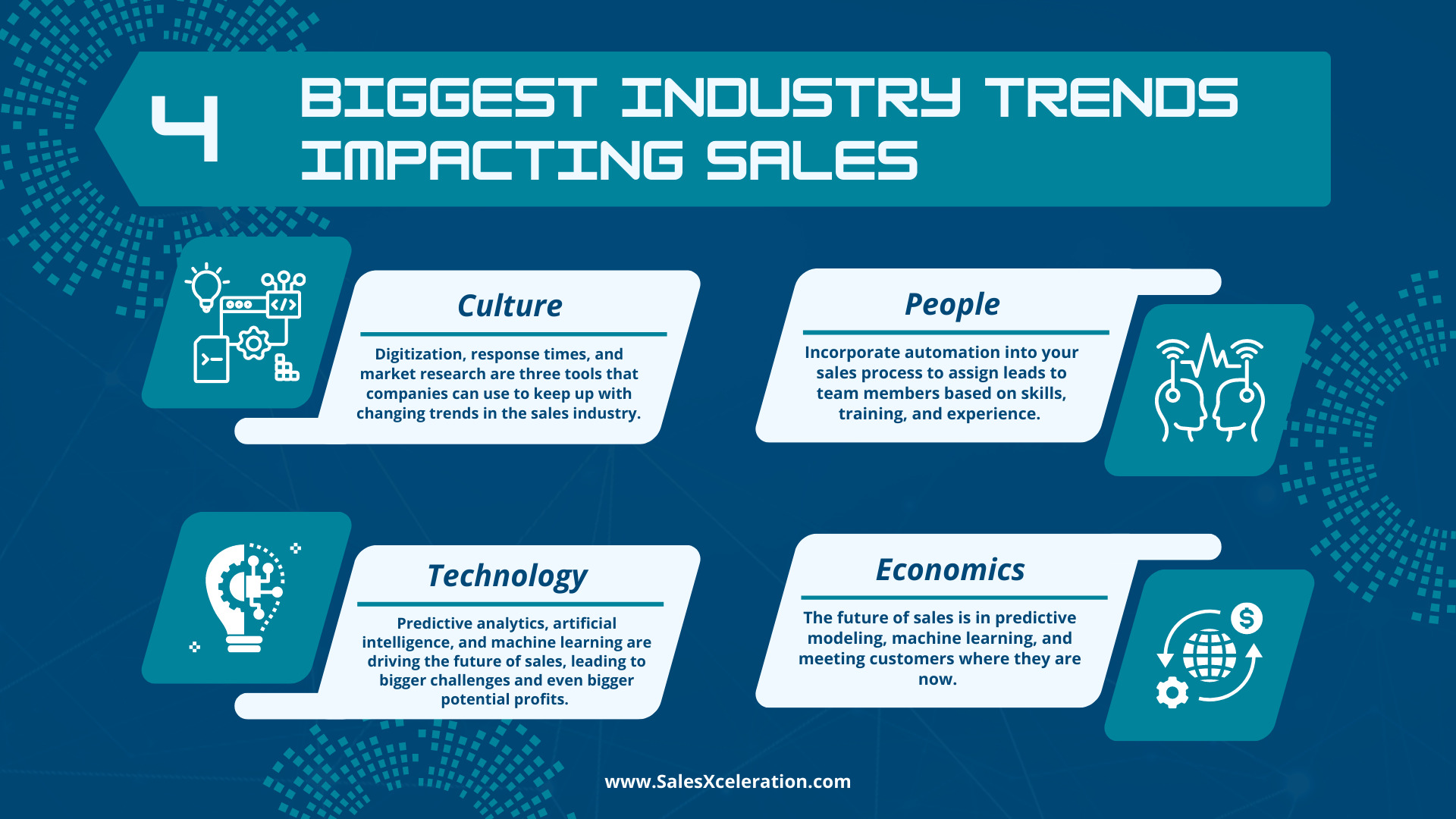
Summary: As the sales world adapts to an evolving global market, companies that follow industry trends and adopt innovations in data-driven technologies will retain their competitive edge.
In the competitive, fast-moving world of sales, keeping up with the latest industry trends is essential. Efficient sales teams know that their continued success relies on a growth mindset that permits them to adapt to the needs of an ever-changing market. By understanding the latest developments, innovations, and market trends, sales professionals can ensure their competitive edge and deliver the perfect products and services for buyers.
There are several benefits to understanding the trends impacting the sales profession. Significantly, it affects a sales team’s ability to forecast changes in the market. Predicting market changes and understanding global sales trends allows sales professionals to make informed business decisions and keep their companies competitive. Investing in market research to keep up with these trends can actually save companies money and time in the long run. Rather than wasting resources on costly mistakes, business leaders can focus on adapting to meet buyers’ needs. Their willingness to embrace trends will allow them to provide their clients with the hottest products and services on the market, giving buyers an exceptional purchasing experience.
At a recent workshop focused on the future of sales, over 125 sales experts and leaders met to identify the possible top distributors affecting sales. Once broken up into teams, these experts were asked to review 70 topical variable cards within the following categories: people, culture, technology, governance/geopolitics, economics, and the environment. At the end of the discussion, each team chose the top three issues they believed would have the highest impact on the future of sales. In the end, four categories were selected as the clear winners: culture, people, technology, and economics.

Section 1: Culture
While there are still unknowns about the future of sales, one thing is certain: Faster and more disruptive change is on the horizon. One of the most significant predictions for the market is that there will be more disruptive change vs. incremental change — something that future sales team training practices should reflect. Innovation, product evolution, and changing purchasing patterns will force faster, more extensive improvements. The buyers of tomorrow will want partners that recognize change and keep up with the latest direction. They need bold experts who are dedicated to evolution and adaptation.
As international trends become the dominant market force, global culture will have a marked influence on these changes. Consider, for example, the influencers and tastemakers of social media, whose position in pop culture enables them to shift beauty standards, behaviors, and lifestyle choices. In this way, culture will ultimately be a strong future sales driver. It will even affect the future of sales jobs as companies respond to these trends.
Disruptive change is usually caused by large-scale events, such as the COVID-19 pandemic. These events can seriously impact businesses by raising demand for new services, causing fluctuations in product prices, and increasing research costs. Companies that adapt to these massive changes efficiently and quickly will find a ready market and new buyers. By capitalizing on new trends, companies can increase profits, stay relevant to their demographics, and expand their offerings and sales locations. Conversely, businesses that resist change and do not adopt new innovations or sales techniques will see declining profits and lose out to more competitive companies.
Digitization, response times, and market research are three tools that companies can use to keep up with changing trends in the sales industry. Companies with a strong digital foundation can more efficiently respond to market shifts. Similarly, staying up to date with market research helps ensure that companies can make internal changes and swivel their product and service offerings as new challenges arise. Businesses that keep a finger on the pulse of the industry will maintain their competitive edge in a constantly evolving global economy.
Section 2: People
Automation will overwhelmingly influence the future of sales jobs. According to Zippia, 46% of current jobs will be automated by 2030. These changes in the global job market will require many people to upgrade their skills, retrain, or even switch occupations. Still, as scary as that statistic might seem, the real-world application of automation in the workforce could take many different forms. Obviously, the cost of automation, the specific skill being automated, job availability, and location can influence how automation plays out in the near future.
While it’s possible that almost half of all jobs will be automated within the next 10 years, some industries will be more affected than others. Manufacturing, for example, will have higher rates of automation than administrative or creative roles. Nothing can replace the human element in sales pitching, but that doesn’t mean sales teams shouldn’t incorporate automation into their processes. For example, depending on where the buyer is in the purchasing process, automation could assign leads to team members based on skills, training, and experience. This would permit the delivery of the perfect sale to the ideal salesperson every time.
This new reliance on automation technologies will require businesses to reevaluate their hiring strategies, team distribution, and sales techniques. Companies may need to move employees to other departments, expanding or compressing teams to ensure that talent is used most effectively. To accomplish this, businesses must invest in employee training programs and personal development. Sales experts and professionals will also need to be flexible in the new world of work. This might mean changing perspectives about automation and cultivating an open mindset about change. Companies that resist new technologies will only harm their chances of success.
Section 3: Technology
Predictive analytics, artificial intelligence, and machine learning are driving the future of sales, leading to bigger challenges and even bigger potential profits. Advances in machine learning mean that artificial intelligence and predictive data are merging with better, more functional algorithms to change the experience of commerce. One of the most significant ways these technologies will impact sales is through personalization. With access to more advanced data on potential buyers, sales professionals can deliver better sales interactions.
Through the use of data mining and statistical analysis, machine learning has already reached new heights in understanding buyer behavior and producing predictive sales models. Machine learning algorithms can identify trends and patterns within massive datasets, allowing them to forecast potential results and offer practical strategies for sales teams. What’s more, they can operate anonymously and adapt their algorithms to incoming information. Essentially, these machine learning systems are able to evolve and improve almost instantaneously. Their applications in sales are limitless and will revolutionize the industry.
Additionally, artificial intelligence can track a team’s response to a lead by analyzing pitches, voice inflection, and word usage. This data can then be used to monitor and improve the sales team’s approach. With new developments in text processing, natural language processing, and computer vision, sales teams can employ personalized sales techniques at every stage of the buyer’s journey.
Part of the widespread changes brought on by data-first strategies will be in the workforce. Most jobs will become increasingly data-focused as companies leverage analytical technologies. Sales professionals with experience in data analysis will find a high demand for their skills in the job market because companies will recognize the need for sales experts who can interpret and utilize large datasets. Businesses will continue to invest in data-first technologies and prioritize sales teams that can utilize data-first strategies to stay competitive.
As predictive analytics, artificial intelligence, and machine learning become commonplace in the office, sales teams must be ready to incorporate them into their day-to-day operations. Companies should invest in these technologies and train their sales force to utilize them skillfully. By better understanding the buying behavior of their key demographic, businesses can tailor their sales techniques and more effectively pitch to the buyer.
Section 4: Economics
While no one can discount the skills of an experienced sales professional when it comes to closing a deal, it’s also true that selling on a “hunch” will no longer be enough. The future of sales is in predictive modeling, machine learning, and meeting customers where they are now.
Here are a few ways technology can disrupt sales when it comes to economics:
- Predictive analytics can help regional and global expansion, where ambitious companies aim to expand their client base and potential buyers. With predictive analytics, sales teams can make more effective decisions when interacting with clients or in a new market. By analyzing buyer behavior in a specific region, sales teams can better predict which products or services will be popular during a season or event.
- Data-first analysis can maximize the output of a sales team, saving precious time by handing sales professionals the information they need to complete a sale. This is doubly true for companies that engage in e-commerce, where automation can offer relevant service or product upgrades, recommend new products, and streamline the purchasing process.
- Another area where companies can see positive results from machine learning and data-first strategies is in reducing risk. For example, predictive models can work in tandem with credit scores to analyze a buyer’s purchasing capabilities and the possibility of default.
Still, predictive modeling has applications beyond the day-to-day quotas of sales teams. By using machine learning and data analysis, companies can create predictive forecasting models to prepare for possible economic recessions, market downturns, and even natural disasters. Through the use of pre-crisis and post-crisis data and buyer-behavior research, companies can predict product demand and sales results for a wide variety of categories. With access to such significant data, companies can create more accurate scenarios for revenue projections, leading to more accurate financial planning.
Conclusion
The future of sales will inevitably involve widespread disruptive change and evolving technologies. By understanding industry trends and adapting to new techniques and opportunities, companies will be able to meet future challenges. The oncoming artificial intelligence and machine learning revolution will permit sales professionals to overcome cultural changes and bring a better sales experience to buyers everywhere. Ultimately, companies that embrace the possibilities of automation and digitization will outcompete those that don’t.
Want to learn more about how data-first analysis and predictive modeling strategies can increase sales revenue and create more effective sales teams? Contact Sales Xceleration today to take a free sales assessment.
Related posts:
No related posts.

